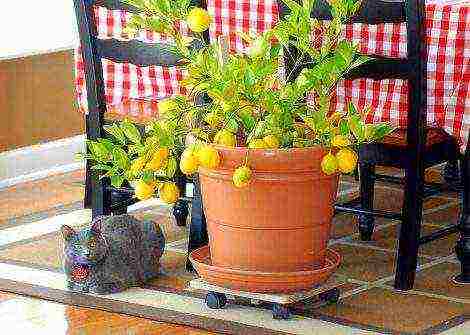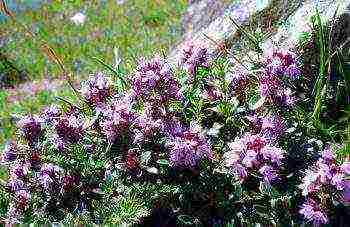Content
- 1 What should be the cellar?
- 2 Substrate preparation
- 3 Planting mushroom mycelium (inoculation)
- 4 Forcing fruiting bodies
- 5 The best varieties to grow
- 6 Landing on a regular horizontal ridge
- 7 Growing mushrooms at home on shelves
- 8 How to grow champignons in a basement in regular bags
- 9 Container way
- 10 How to grow champignon mushrooms in blocks and what is it
- 11 Where to start a business?
- 12 Business registration
- 13 What conditions are required for work
- 14 What preparation of the premises is needed before growing?
- 15 Champignon cultivation technology
- 16 Growing process
- 17 Sales channels
- 18 Calculation of financial investments
- 19 Profitability and payback of the mushroom business
- 20 What risks await an entrepreneur?
The microclimatic conditions of the cellar are ideal for growing mushrooms. Everyone can buy mycelium and master the technology of growing mushrooms in the basement. If you want to get a good harvest, first of all, you should pay attention to such things as: preparation of the nutrient substrate, equipment of the room, disinfection, temperature and humidity control. Let us examine these and other questions in order.
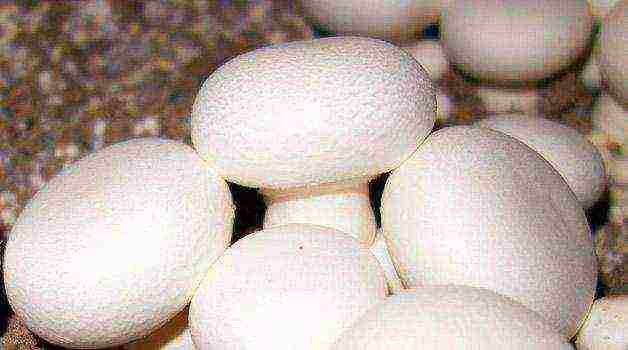
What should be the cellar?
You can grow mushrooms in any well-made cellar. The floor in the cellar should be concrete, not earthen. In general, the cleaner and more isolated from external influences the room is, the better.

To save space in the basement, racks with mushrooms are equipped with several floors (tiers).
Lighting
Unlike green onions and other plants, mushrooms do not need additional lighting. They can be perfectly grown in the dark. The light should be screwed in only so that it is convenient to work in the cellar or basement.
Ventilation
The cellar should be equipped with a ventilation system, since the compost on which the mushrooms grow actively releases carbon dioxide during decomposition. And mushrooms do not tolerate mustiness. Carbon dioxide must be removed and replaced with fresh air. However, drafts should not be allowed. The ventilation pipes are closed with a fine mesh to prevent insects from getting inside.
If there are not enough conventional supply and exhaust pipes for good ventilation of the cellar. We'll have to take care of the forced ventilation of the room. Additional fans can be used to circulate air above the mushroom boxes. If possible, it is worth installing additional air purification filters.
Temperature and humidity
To control these indicators, install a thermometer and a hygrometer in the mushroom growing room. You can increase the humidity by spraying the racks and the floor with a spray bottle. Reduce - by airing.
The temperature in summer can be regulated by ventilation, but if you plan to grow mushrooms all year round, take care of additional heating of the cellar.
Space zoning
If your cellar is large enough, it makes sense to divide it into two zones. You will use one room for incubation (spreading the mycelium over the substrate), and the second for the direct forcing of mushrooms (fruit bodies). The temperature for the successful course of these processes is different. The mushroom grows at about 23 degrees, and fruiting occurs at 16-17 degrees.
By maintaining stable temperature conditions in each room, you can simply carry the substrate boxes. In this way, you can grow champignons continuously - while half of the boxes bear fruit, the mycelium grows in the other, and so on.If necessary, add a third composting area.
Pre-disinfection
To grow mushrooms, the basement must be well disinfected, treated from parasites and mold. Champignons are very susceptible to disease and pest infestation, and it will be a shame to lose most of the crop due to neglect of safety measures at the initial stage.
In particular, the following processing can be carried out:
- Fumigate with a sulfuric stick.
- Whitewash the walls and ceiling with lime with the addition of copper sulfate.
- Spray with a 4% formalin solution.
- If there were previously vegetables in the basement, and fruit flies or other pests were bred, you need to treat the room with chlorophos.
- As an additional protective measure, a box of sawdust soaked in a disinfectant solution can be placed at the entrance.
After disinfection, the basement should be thoroughly ventilated, otherwise not only the mushrooms, but also it will be very difficult for you to be inside.
Substrate preparation
The preparation of the nutrient medium on which the mushrooms will grow is one of the most important and crucial moments. To grow the maximum yield, prepare the substrate by following the recommendations on the mycelium packaging you purchased. Since the strains or varieties of champignons are different, the preparation technology and the composition of the substrate may differ insignificantly.

It looks like the substrate on which the mushrooms grow.
However, there are general principles for preparing compost for growing mushrooms, which can be considered universal. The best option would be natural horse manure compost. It is important that the animals eat hay and not green food.
Two options for making natural compost:
| 1 | Horse manure with a high straw content, humidity 40-45% | 850 |
| Urea | 3 | |
| Superphosphate | 13 | |
| Ammonia saltpeter |
8 | |
| Gypsum | 18 | |
| 2 | Horse dung | 2000 |
| Straw | 50 | |
| Urea | 5 | |
| Ammonium sulfate | 8 | |
| Superphosphate | 5 | |
| a piece of chalk | 7,5 | |
| Alabaster |
Horse manure can be replaced with cow or poultry droppings, however, in this case, the yield will be significantly lower.
The straw is soaked for a day in warm water in a convenient trough or other container. After that, it is stacked in a pile mixed with layers of manure. You should end up with only 6-8 layers. We additionally moisten each layer with warm water. After 3-4 days, the compost should be thoroughly mixed and added with urea and superphosphate. After that, the substrate will acquire a characteristic ammonia smell. After another 3-4 days, the compost is mixed again. So it needs to be shoveled 4-5 times, gradually adding the rest of the minerals. During the last mixing, gypsum is added.
The average compost time is 24–28 days. The completion of the fermentation process can be judged by the disappearance of the ammonia smell and the light brown color of the manure. During the fermentation process, the temperature of the compost can reach 50–70 degrees. For growing mushrooms, the temperature of the compost should be no more than 25 degrees.
It is worth preparing the substrate either in a special utility room with good ventilation, or outdoors under a canopy that protects from rainwater and the sun. We do not pour compost on the ground, it is better to spread cellophane. This is required so that insect pests do not get into the finished substrate.
If it is too difficult for you to prepare your own mushroom substrate, you can always buy it in the store. However, hand-made compost is usually of better quality.
We move the finished substrate to the basement and put it in boxes or containers in which it is planned to grow mushrooms.
Planting mushroom mycelium (inoculation)
So, the substrate is ready and placed in the cellar, now it is required to add the mycelium of the fungus to it in order to grow the mycelium. The mycelium is grown industrially in laboratories under sterile conditions. You can buy it at gardening stores or order it online.

Grain mycelium.
In order to grow mushrooms on 1 square meter of substrate, you need 500 g of compost mycelium or 400 g of champignon cereal spores.
We place the "seeds" in the substrate. If you've composted it correctly, it should bounce slightly when pressed. We make five-centimeter depressions at a distance of 20 centimeters from each other and put a small amount of compost mycelium in each depression. If you have purchased champignon spores, you just need to scatter them over the surface. Gradually, the strings of mycelium will begin to grow over the substrate.
The growth time of the mycelium, while the fruiting bodies of the mushrooms have not yet appeared, is called incubation. During this period, it is necessary to maintain the air humidity in the cellar at the level of 70–95%. To prevent the substrate from drying out, it can be covered with paper or cloth and periodically sprayed with a spray bottle.
The temperature at which mycelium grows is 20–27 degrees. The mushroom filaments will begin to actively spread in ten to twelve days. Then the surface of the substrate should be covered with earth by 3-4 centimeters and wait another 3-5 days. The land is not just from the garden, but a mixture of peat (5 parts), limestone (1 part) and soil (4 parts). Do not forget to sprinkle with water occasionally.
Forcing fruiting bodies
After the incubation period, you should lower the temperature in the cellar to 12-17 degrees, or move the boxes with the substrate to the room for distillation (if, as mentioned at the beginning of the article, you divided the room into two compartments). The period of growth of the mushrooms themselves begins.

For one harvest, 5-8 waves of mushrooms can be removed from the mycelium, although the bulk will fall on the first three waves.
You can remove the first wave of the harvest in 3-4 months. Prevent mushrooms from overripe. You should pick them off when the lower part of the cap is still covered with a white film and the brown plates are not visible. Each mushroom must be carefully twisted out of its place, not cut off. From the leg remaining after the cut, bacteria can get into the mycelium.
After collecting the mushroom, the place where it grew should be lightly sprinkled with soil. The champignons will grow vigorously within 1–2 weeks. Under the right conditions and good compost, 5–8 harvests of mushrooms can be harvested during this time. The main volume falls on the first three waves. Then the yield of mycelium will sharply decline.
The best varieties to grow
More than fifty different varieties of champignons are known in the world. Some of them are found in the wild, and some are bred by breeders for industrial breeding.
For growing in a cellar, varieties with high yields, easy to care for and unpretentious are ideal. Among them, one can distinguish two-pore and two-ring. Also suitable for home breeding of meadow mushroom, Somycel 512 and Hauser A15.
The technology for growing mushrooms in the basement has its own characteristics, but it is not as complicated as it seems at first glance. If you have prepared the right compost, established the required microclimate in the cellar and purchased good planting material, you are guaranteed a high yield of mushrooms! And our recommendations will help you cope with this creative and interesting task.
Landing on a regular horizontal ridge
As expected, let's start with the cheapest, simplest method that will satisfy the needs of many farmers. An ordinary garden bed is a layer of soil with fertilizers, which is located in a basement, a greenhouse. An old vegetable store, a shallow mine, an indoor poultry house, etc. are ideal for growing. The main thing is that there is high humidity in the room, and the temperature is a secondary indicator, it can be adjusted using heaters. Consider the step-by-step instructions for growing mushrooms on the ridge.
> Step 1:Laying compost.
First, the floor is leveled, then a plastic wrap is laid on it, which will retain moisture. Compost up to 30-40 centimeters thick is applied to it.
> Step 2:Sowing with mycelium.
The purchased seed can be sown immediately into the furrows previously made in the compost, it can be scattered on top, and then covered with another layer of compost of 4-5 centimeters.
> Step 3:Watering and maintaining the temperature.
It is necessary to fill the crops abundantly so that they are constantly saturated with moisture, only then the mycelium will grow well, and new fruiting bodies will appear within 10-12 weeks after sowing.
Today, more than 80% of all farmers use this method, since it is really profitable. There are many advantages of this method, let's take a closer look at them.
- There is no need to purchase expensive trays, so you can save 600-700 rubles for one.
- Quick bed equipment. It can be done in almost 1 day, you just need to pour the ready-made compost. With trays, bags, there is much more red tape.
- Rational use of the usable area.
There are, of course, more disadvantages. First of all, we pay attention to infections. If they occur, they spread throughout the garden, and this can be a very serious loss. You also need to take into account that it is impossible to clean the room, therefore, sooner or later, infections brought by shoes from the street or simply on a person's clothes will start... Another disadvantage is the inability to raise the bed to a comfortable height, so manual labor will be much more difficult than with Dutch technology.
Growing mushrooms at home on shelves
This is a more modern way, which provides for convenient placement in drawers. This is the so-called Dutch cultivation method, which provides for the rational use of the indoor area, as well as the highest quality care. The shelf system provides for the use of special mechanized equipment, therefore it is considered more expensive. Many farmers abandoned this method precisely because of its relative high cost. The minimum start-up capital for a 50 square meter facility is $ 8,000.
The profitability of production starts from only 6 kg / 1 m2, so it will be profitable to grow only good hybrids that will produce a lot and often. But, with good yields, the method is very practical, since labor costs are reduced by 2-3 times compared to horizontal ridges. As a container for the substrate, plastic forms are used, from which rows are made, they go one above the other. Drip irrigation is necessary, since with conventional sprayers, infections that enter the upper row will quickly spread to the lower containers.
How to grow champignons in a basement in regular bags
This is the most popular method for oyster mushrooms, but in recent years, mushrooms have also begun to gradually move to polyethylene, since this is one of the most practical methods to get a good harvest with little labor and low material investment. Let's take a closer look at how to make the mushroom grow out of the bag.
> Step 1:We prepare the substrate.
For this we need 15 kg of horse manure, 3 kg of straw, 2 kg of sunflower husk, 5-6 kg of black soil, 2 kg of mullein. We mix all the above ingredients and get an excellent mixture for planting mycelium.
> Step 2:We are waiting for it to burn out.
Fill with plenty of water and wait for a temperature of +80 degrees. After 20 days, spread the soil mixture with a thin layer, dry it.
> Step 3:We throw everything into a bag.
Everything is simple here. We fill the bag to the top, make it very dense, pour water into it so that the moisture content of our mixture is as high as possible.
> Step 4:We sow the mycelium, put the bags.
Holes are made in the bag, about 10 centimeters in diameter, in a checkerboard pattern so that the bag does not burst. You get a polyethylene surface in a mesh, where you will need to place a mycelium in each cell.
The technology allows you to save on the purchase of containers, but, at the same time, gives all the advantages of shelf cultivation.If an infection gets into one bag, you simply throw it away or disinfect it, bacteria do not spread to neighboring blocks. Of the shortcomings, the most significant is manual labor at the first stage, which will take a lot when filling each bag, stirring, moistening, planting mycelium.
Container way
Americans are the most knowledgeable about how to grow mushrooms at home. It was they who came up with the aerated (ventilated) growing containers. This method allows you to get fresh fruit bodies even on the balcony in the apartment, not to mention the basements. To do this, you need a special container with a lid and a pallet, into which all the moisture will drain. The compost is prepared as for growing in bags, after which it is placed in wooden containers, previously disinfected at a temperature of +200 degrees in an oven.
Then the mycelium is sown to a depth of 4-5 centimeters, the soil is moistened, placed in a warm place (the temperature is needed up to +28 degrees). The method is very effective and convenient, especially when an infection enters the soil. You can easily localize the epidemic, since it will not go further than one container. The biggest disadvantage of this method is the high cost for an industrial scale, so farmers very rarely use it in Russia. If you have not yet figured out how to grow mushrooms at home without unnecessary "dust and noise", then this one will suit you. Compact containers fit in any basement or room.
How to grow champignon mushrooms in blocks and what is it
Blocks (or as they are also called - briquettes) are presses specially prepared for production from manure, husk of seeds, sawdust, peat. The ideal ratio of all components, as well as high-quality mixing on the production equipment, will benefit the future harvest.
The advantages of this growing method are many. You do not waste time, effort, money on the construction of beds, you get ready-made material. Typically, compost is sold in cylindrical or rectangular polyethylene blocks. You can hang it on a rope, or simply put it in a prepared metal container. It is very easy to change it, so growing mushrooms at home does not require much effort: we collect 3-4 waves of mushrooms and discard the "filling" of the metal box. We buy a new briquette, put it in, add mycelium. The main disadvantage of this method is the same as in the previous one - the cost. However, since the first 3 waves give about 80% of the crop, then such a frequent change of the substrate will be to some extent even beneficial if you want to get stable and large champignon yields.
Rate the article:
(0 votes, average: 0 out of 5)
Growing champignons in the basement is most often perceived not as a business idea, but as a strange hobby of an amateur gardener. However, with such an occupation, you can really make a profit! To do this, you just need to competently approach the matter: draw up a business plan, calculate profitability and investments, assess risks.
If you are interested in the idea, let's get down to the debriefing!
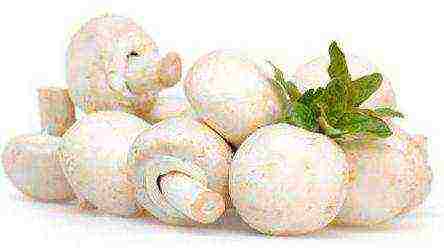
Where to start a business?
Growing mushrooms in the basement of a residential building is a very real idea for implementation. Why not, because the microclimate is fully consistent with the conduct of such an activity, and mushrooms are completely picky about the conditions.
A step-by-step algorithm for organizing a business can be presented as follows:
- Understand the technology of growing mushrooms.
- Prepare a basement for placement of seedlings.
- Disinfect the premises.
- Buy mycelium.
- Purchase compost or raw materials for its production.
- Plant the mycelium in the substrate.
- Control temperature and humidity levels.
- Harvest according to the prescribed rules.
- Find points of sale and sell the product.
We will analyze each point of organizing the cultivation of mushrooms in your own home.
Business registration
The cultivation of mushrooms as a business (in the basement) must be officially registered. Unless, of course, the volume of your production is limited by the limits of "a batch for yourself, a batch for neighbors."
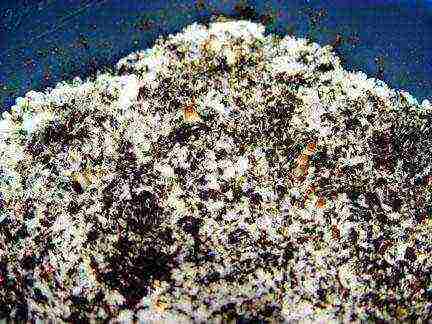
When it comes to business specifically, and especially about implementation through retail outlets, cafes, etc., you cannot do without documents.
Do not worry if you haven’t come across this question before. It's pretty simple. Let's represent your actions in the form of a step-by-step algorithm:
- It is necessary to register an individual entrepreneur. To do this, you need to go with your passport to the nearest tax office.
- As an indication of the activity, you choose agricultural production and sale.
- With this type of work, you can count on a single agricultural tax - 6%. This is a very profitable taxation option.
- The room for growing mushrooms is subject to inspection by employees of the phytosanitary inspection. The basement must have a permissible background radiation. After verification, you will be issued a certificate.
- Also in the phytosanitary inspection, you will check the goods before selling. No serious client will cooperate with you without a certificate of quality. The validity period of one certificate is the "life" period of one batch of compost. You will provide this data during registration.
Next, let's take a closer look at the conditions for growing mushrooms in the basement.
What conditions are required for work
Growing mushrooms in the basement of a private house follows the same principles as in any other place. We'll talk more about the technology later. Now let's figure out what conditions are necessary to get a bountiful harvest of mushrooms.
Growing champignons in the basement of a garage or other room presupposes a solid, solid building. We will analyze the rest of the requirements in stages:
- Contrary to popular belief, the floor should be covered with concrete, not dirt.
- The room itself is maximally isolated from the environment, excluding the possibility of contamination sources from outside.
- Another difference from other types of vegetation grown for sale: champignons do not need a constant source of light. This translates into substantial savings in equipment and utility bills. It is enough to hold one lamp in the basement to work with convenience.
- Even in a small area, it is possible to organize the cultivation of a significant amount of the crop. To do this, the containers are installed "in layers", placing ordinary racks in the basement. The growth height of the mushrooms is small, which allows you to make tiers at a short distance.
- It is important to consider this feature: the mushroom compost will emit unpleasant carbon dioxide. It is unpleasant because it leads to mustiness. And mushrooms do not tolerate such a situation. Establish an efficient ventilation system to avoid problems.
- Do not overdo the ventilation of the room. Drafts are also the enemy of your seedlings. It is also worth installing a mosquito net with small meshes on the ventilation holes to prevent insects from getting inside.
- Mushrooms, however, are unpretentious to the temperature regime. Try to maintain an "even" level, that's enough. In summer, a fan is used if necessary. Growing champignons in a basement in winter may require installing a heating system (if the room is very cold).
- Control the humidity level in the cellar. It can be reduced by ventilation, and increased by a simple spray bottle with water.
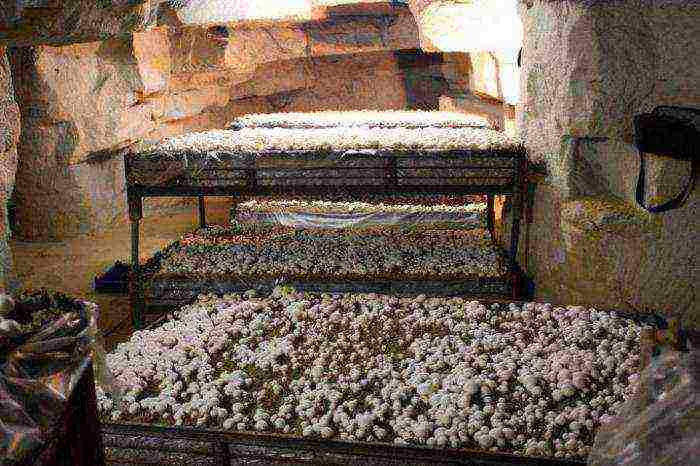
What preparation of the premises is needed before growing?
Like many other mushrooms, mushrooms are susceptible to diseases and parasites. Growing in the basement (the technology of the process is, in fact, extremely simple) requires careful preparation of the place before work begins. Preliminary work consists of disinfecting the room, treating surfaces, removing mold and even a chance for its appearance in the future. If you do not approach this issue carefully, the crop can be spoiled.It's a shame to destroy a case for several months out of sheer laziness, isn't it?
If you do not want to check the resistance of fungi to a harmful environment, prepare the territory like this:
- Examine the room for insects (it is important if vegetables were previously stored in this cellar). If you find at least a few individuals, be sure to process chlorophos.
- All surfaces are covered with lime, to which copper sulfate is added.
- Use a sulfur stick to fumigate the room.
- Also, the space is sprayed with a 4% formalin solution.
- Want to insure yourself? Take a deep container of sawdust and sprinkle it with disinfectant. Place the box at the entrance to the cellar. It will serve as an additional barrier for pests.
- After carrying out the manipulations, carefully check the basement. Otherwise, you can harm not only the seedlings, but even your own health.
Sometimes simple airing does not give much results. This indicates the fact that you need an additional ventilation system. For example, you can put additional fans above the racks with mushrooms. As your business expands, it makes sense to invest further in installing air purifying filters in the ventilation system.
Champignon cultivation technology
What is the principle for planting champignons? Growing in the basement (process technology, to be more precise) has some features:
- Zoning. It is recommended to divide the basement into two parts - for the incubation period and for direct distillation. The fact is that you will need to observe different temperature conditions. Zoning the space will greatly facilitate the task.
- As mentioned, each period needs its own temperature. For cultivation - 23 ° C, distillation - 12-17 ° C.
- Carefully follow the composting conditions indicated on the packaging. Horse manure is considered the best base. When using it, an increased yield is noted.
- A self-made substrate will always be better than a purchased one. But to save time and effort, it can still be purchased.

Growing process
When all the conditions for growing mushrooms in the basement are met, you can proceed directly to the process. The easiest way for beginners will be to imagine it in the form of a step-by-step algorithm:
- We plant the mycelium in the substrate. Typically, entrepreneurs purchase mycelium ready for planting to grow at home. Most often it is a base grown in special laboratories in which ideal conditions of sterility are maintained. They buy mycelium for planting through intermediaries - on the Internet, in All for Garden stores, as well as directly from suppliers.
- It is very simple to calculate the required amount of mycelium: 1 m2 - 500 grams of "living" medium. If you decide to grow mycelium from spores, you need 400 grams.
- The planting process is not very different from the usual one: you need to make holes about 5 cm deep. Properly prepared compost will feel a little springy. Keep a distance of at least 15-20 cm between the holes. Place a piece of mycelium in each hole.
- For planting spores, holes do not need to be made. The seeds are simply poured evenly onto the ground. The mushroom pickers will pave their own way.
- During the incubation period, the entrepreneur's task is to monitor the level of humidity and temperature. How to do this is described in more detail below.
- For permanent moistening of the earth, you can cover it with paper (cloth) and moisten it.
- 10-12 days after planting, cover the substrate with another layer of earth - literally 3-4 cm. The earth is prepared in a special way: peat + lime + soil in a ratio of 5: 1: 4.
- The incubation period will end in 4-5 days. During this time, regularly moisten the air and soil with a spray bottle.
- The next growing period is forcing. At this time, the temperature in the basement is lowered to 12-17 ° C. Sometimes this is difficult to achieve, it is much easier to move the racks to another room. For this, in the section above, it was proposed to zone the basement.
- The mushrooms will start growing soon.Observe the rules for collecting them and do not over-ripen the mushrooms.
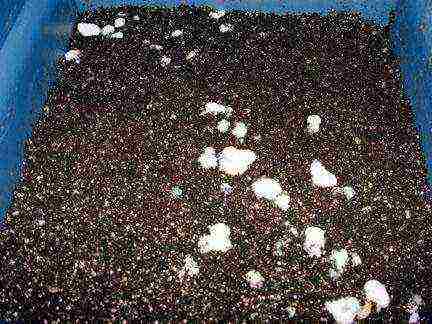
Sales channels
A rare person in our time does not use champignons. Growing at home in a basement can meet the needs of one family of mushrooms. But when it comes to business, of course, it is necessary to establish distribution channels. Finding clients is the secret to the success of this endeavor.
Growing champignons in a cellar rarely involves a large amount of mushrooms harvested. Therefore, the surplus that family members do not use can be sold in the nearest market.
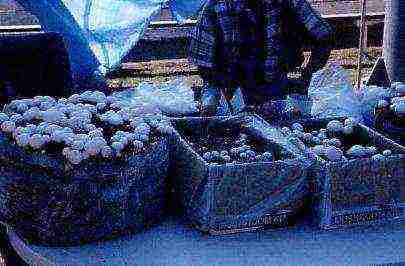
If the business is still put on stream and you want to find a more "solid" sales market, consider the following options:
- It is not necessary to sell the mushrooms directly to those who consume them. Using intermediaries can reduce your profits, but it will provide you with a steady stream of orders. Whether such a scheme is beneficial in your case, decide for yourself.
- Shops, supermarkets, cafes and restaurants can act as an intermediary for the sale of mushrooms.
- If you get a solid harvest, it makes sense to look for an opportunity to conclude a supply agreement with manufacturers of semi-finished products (champignons can be part of pancakes, pizza) or cookery.
- A good idea for promotion is to create your own website. On it you can post useful information for the consumer about mushrooms in general and champignons in particular. The price list, potential discounts, terms of delivery of products to customers, contact information are also indicated there.
Calculation of financial investments
Growing champignons in the basement, which is positioned as a business, will be quite cheap. Of course, it all depends on the resources you have and the planned production volumes. However, the absence of the need to pay for the rent of the premises is already a big plus!
It is also important to note that by growing champignons, an entrepreneur frees himself from such a large cost item as buying equipment. It is on technology that the lion's share of the budget is usually spent when organizing a business.
Consider the remaining cost items for 1 cycle of mushroom cultivation:
- raw materials for the manufacture of 1 ton of compost - 1000 rubles;
- mushroom mycelium - 500 rubles;
- creating the necessary conditions in the basement - 2000 rubles.
In total, we get the amount of 3500 rubles. As you can imagine, this is a ridiculous price to pay for starting your own business, albeit modest.
Profitability and payback of the mushroom business
If you have correctly considered all the requirements for growing white champignon in cellars, each mycelium can bring you 5-8 harvests. It is worth noting that only the first three will bring the main amount. Typically, the growing cycle is 1-2 months.

Follow these rules when harvesting:
- Control the state of the mushrooms - they must not be allowed to overripe.
- It is easy to determine the right moment for collection - the bottom of the champignon cap is covered with a white film.
- Champignons that are grown at home are not cut, remember this! You just need to gently twist them around their axis and get them out.
- When you get the mushroom, sprinkle it with earth.
- If you follow simple rules, new mushrooms will grow for several more weeks.
Let's calculate the estimated profit from the business:
- 1 ton of compost is 200 kg of mushrooms, if all conditions have been met;
- 1 kg of this type of mushroom is now estimated at 100-150 rubles;
- profit from 1 harvest cycle - 20,000-30,000 rubles.
As you can see, the ROI is 100%. The investment will pay off within a few months.
What risks await an entrepreneur?
Growing champignons in the basement of a house, like any other business, involves certain risks for an entrepreneur. You need to know them and, if possible, minimize negative consequences.
- Although one cannot speak of high competition in this area, it is difficult to find a stable sales market. Start building partnerships before harvest, as the product spoils pretty quickly. You can familiarize yourself with the ideas for finding buyers above.
- Champignons are not particularly whimsical mushrooms. However, they are also susceptible to diseases, as well as other factors that affect productivity. Monitor compliance with all growing rules and the condition of the mycelium.
Growing champignons in the basement is a worthy business option at home. It has a number of advantages at once: low competition, minimum starting budget, 100% profitability, ease of planting and caring for mushrooms. However, it is possible to get decent revenue only if the entrepreneur establishes a permanent sales channel. If you find enough buyers or one, but wholesale, you can recoup your investment and make a profit after the first harvest.
And be sure not to be too lazy to draw up a business plan before starting to implement the idea in order to make calculations in detail and outline the work scheme.
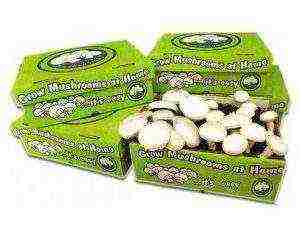
Even a novice mushroom picker can grow champignons, it is enough just to find out what conditions it is important to create for the cultivation of such mushrooms.
Breeding
You can breed champignons in different ways, but taking into account the following features:
- The mycelium should be added to the substrate at a compost temperature of about + 25 + 27 degrees.
- For the incubation period, the temperature is maintained at a level of 22 to 25 degrees Celsius, and for the period of appearance of mushrooms, a temperature of 14 to 17 degrees is needed.
- Ventilation is not needed during the incubation period, but during fruiting, it is very important to ventilate the room, since the champignon is quite sensitive to excess carbon dioxide.
- Champignons do not need lighting.
- The collection of champignons is carried out by extracting the mushrooms together with the root. Unscrew the mushroom and carefully separate it from the soil. Such collection will not cause mycelium depletion.
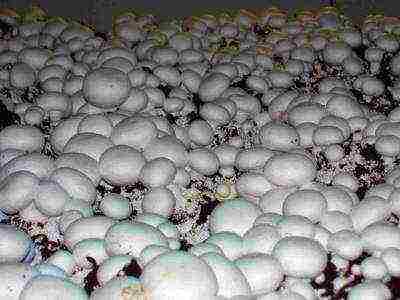
Tools and materials you will need:
- Storage containers
- Shovel
- Polyethylene film
- Sprayer
- Scissors
- Boot
- Irrigation hose
- Urea
- Compost
- Superphosphate
Mycelium
Most often, mycelium is purchased from trusted suppliers. It can be compost (more resistant to external factors) and grain (better quality). From companies selling mycelium, you can also purchase ready-made myceliums.
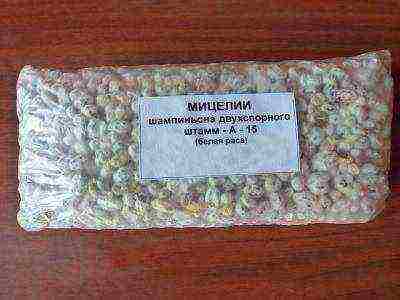
You can prepare raw materials for planting champignons yourself from overripe mushrooms. They are poured with water and left for a day so that the spores get into the liquid. Such a liquid is evenly watered over the soil and sprinkled with a 1-centimeter layer of earth.
You can also use wild-growing mycelium for sowing, taking it in places where mushrooms grow in nature. The mycelium is mined in September - after removing 1-2 centimeters of soil, they take out pieces of soil (a square with a side of 10-30 cm) with the mycelium threads, dry them a little and send them to storage in a cool room until spring. In the spring, it can be planted at a summer cottage. Also, this mycelium can be propagated in a greenhouse or basement.
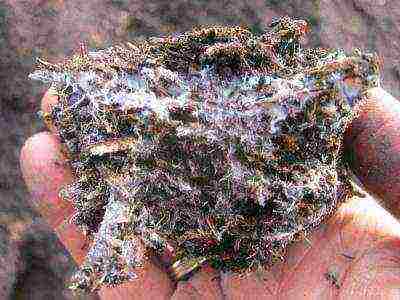 In the beds
In the beds
The most inexpensive and simple method of planting champignons, suitable for many mushroom pickers, is growing in ordinary horizontal beds, which are soil with fertilizers. Such beds are arranged in greenhouses, basements, shallow mines, old vegetable stores and similar premises.
An important condition for such premises is high humidity, and the temperature regime is considered a minor factor that can be influenced by the use of heaters.
The method is considered to be quite profitable, therefore it is in demand among most farmers.
Its advantages:
- No need to buy trays.
- The beds are done very quickly.
- The usable area is used rationally.
But there are also quite a few disadvantages:
- There is a high probability of infection (the premises cannot be cleaned, therefore infections are often brought from the street and on clothes) and its rapid spread throughout the garden.
- The bed is at an uncomfortable height.
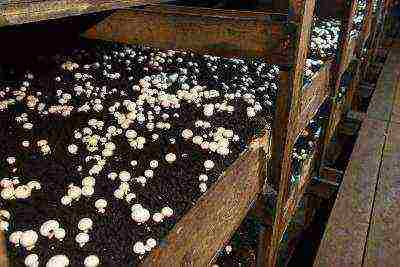
Stages of growing mushrooms in the beds:
- Composting. Lay a plastic wrap on a flat floor to retain moisture. Compost is poured onto this film, creating a layer about 30-40 cm thick.
- Sowing mycelium. Furrows are made in the compost and sown with the acquired mycelium. You can also simply sprinkle the mycelium evenly on top, covering it with compost (about five centimeters).
- Watering. After sowing, the compost should be watered regularly and abundantly. Only with a sufficient amount of moisture will you get good mycelium growth.
- Collection. The fruiting bodies of the mushrooms, ready for harvest, appear in ten to twelve weeks.
At home
A more modern method of mushroom breeding is the shelf system, which is also called the Dutch method. It is based on the use of shelves and drawers. With the rational use of the area with such a system, high-quality care is carried out.
The main disadvantage of growing on shelves is the need to use rather expensive equipment. Such cultivation of mushrooms will be profitable only when using good varieties with abundant frequent harvests. And it is precisely such a high yield that makes the method quite profitable, because the labor costs for such cultivation will be two to three times less than when using horizontal rows.
The substrate is placed in plastic containers, which are laid out in rows. Also, the technique provides for drip irrigation, preventing infections from entering the lower containers from the upper rows.
 In the basement
In the basement
It is very convenient to grow mushrooms in basements, because underground rooms have a relatively stable microclimate. In addition, it is much easier to create optimal conditions in basements than in greenhouses.
You can even grow mushrooms in an ordinary basement. It is desirable that such a basement contains:
- concrete walls;
- concrete or cemented floor;
- good ventilation.
To prevent infection of fungi by pests, ventilation openings are recommended to be covered with nets, and the ceiling and walls should be treated with lime. If the basement is spacious enough, it can be divided into two zones - one will undergo the incubation period of growing, and the second will receive fruiting bodies. To maintain high humidity (85-90%), the basement floor is moistened.
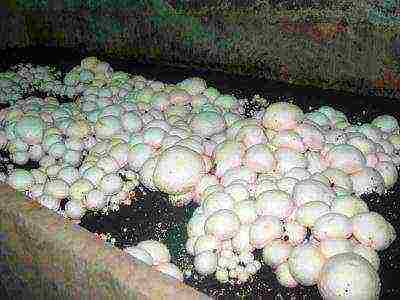 In bags
In bags
Another technique for growing champignon in the basement is the technology by which oyster mushrooms have been grown for a long time. It consists in using plastic bags. This method is practical and gives a good harvest, but it does not require significant material investments.
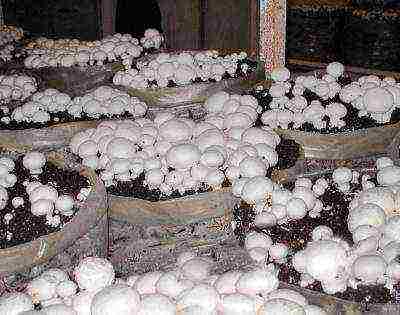
Stages of growing mushroom in bags:
- Substrate preparation. To obtain an excellent raw material for growing mushrooms, mix horse manure (15 kg), black soil (5-6 kg), straw (3 kg), mullein and sunflower husk (2 kg each). By filling this mixture with water, you will see that it heats up to a high temperature and burns out. Leave it on for 20 days, then spread it out in a thin layer to dry.
- Sowing mushrooms. After filling the bags with the substrate to the top and filling them with water from above, then you need to make holes in the polyethylene with a diameter of about ten centimeters. In order not to break the bag, such holes are made in a checkerboard pattern. A mycelium is placed in each cell.
With this technology, you save on containers, but at the same time you get all the advantages of growing mushrooms on the shelves.
If the infection enters one bag, it must be disinfected or simply thrown away and the bacteria will not enter the neighboring bags.
The disadvantages include the rather laborious first stage of cultivation, because a lot of manual labor is needed to prepare the substrate, fill bags, moisten and other work.
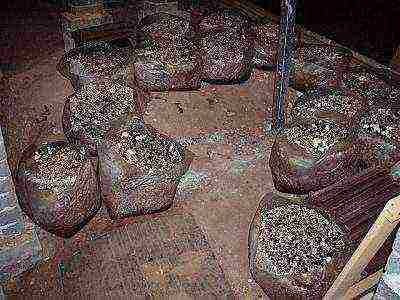
You can also grow mushrooms in briquettes.They are compressed blocks, based on manure, sawdust, husk, peat and other components in the right proportions, placed in polyethylene.
The undoubted advantage of this method is the absence of the need to waste time and energy. The farmer receives the finished material in the form of rectangular or cylindrical briquettes. They can be placed in containers or hung from ropes.
Having collected 3-4 harvests, the blocks are replaced with new ones. The yield of this technique is quite high and stable.
The disadvantages include only the cost of the briquettes themselves.
 In the country
In the country
You can breed champignon in the country in different places: in greenhouses, in the basement, and even just in the beds in open ground. The location is not so important, it is much more important to achieve the conditions necessary for the appearance of mushrooms - a certain temperature regime, sufficient humidity, access to air and the absence of direct sunlight.
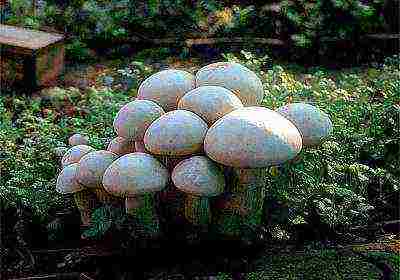 In the garden and in the garden
In the garden and in the garden
In order to grow mushrooms in your garden, it is important to find a shaded place for them, in which nothing is grown.
A good place would be the north side of the site, for example, behind a house, where there is little sun and the humidity lasts longer. The beds are covered with a canopy, which serves as protection from rain and sun. With this cultivation, the ventilation of the mushrooms will be natural, so the mycelium in the ground will not rot.
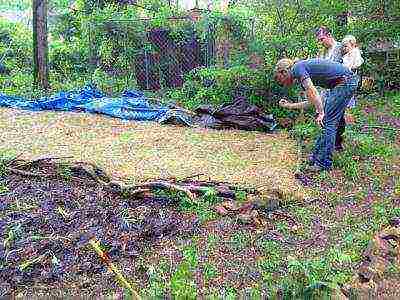
Significant spending on growing mushrooms in the garden is not required. It is only important to properly prepare the compost, the basis of which will be manure (chicken or horse). Urea and hot water are added to the manure, after ten days it is shaken up, mixed with chalk and compacted a little. Another ten days after adding superphosphate, the manure is well compacted and waiting for ripening (it should become light brown and crumbly).
A layer of manure 35 cm thick is laid on the prepared bed, dividing it into sections (squares with a side of 20 cm). The mycelium is planted at an air temperature of about +20 degrees to a depth of about 5 cm, after which it is sprinkled with compost a little, watered with water and covered with newspaper or plastic.
When the mycelium appears (after about 20 days), the shelter is removed and a 3-centimeter layer of turf and peat is poured onto the garden bed. Expect the first mushrooms in 25 days. Collect them on time and water the beds with warm water twice a week.
In the greenhouse
Champignons are classified as unpretentious mushrooms with a fairly high growth rate. These parameters allow them to be grown in greenhouses. Up to 30 kilograms of mushrooms can be harvested from one square meter in a greenhouse at a time.
In a greenhouse, 3-7 harvests can be obtained per year. With this method of growing mushrooms, it is important to control humidity and temperature, use a good substrate, and ensure that excess carbon dioxide is removed.
In order for the mycelium to sprout quickly, after sowing, the soil is covered with polyethylene.
You need to water the crops before the first shoots - when they appear, spray the mushrooms twice a day.
 At home
At home
A great way to grow mushrooms at home is to use aerated containers. Such containers were created by the Americans, providing for the possibility of ventilation in them.
You can grow mushrooms using this method even in an apartment on the balcony. It is enough to buy a special container that has a pallet and a lid. These containers are filled with the same compost that we described when growing mushrooms in bags. Before laying the substrate, the container must be disinfected by holding it in an oven at +200 degrees.
The mycelium is sown into the substrate, immersed in 4-5 centimeters, after which the soil is moistened and the container is sent to a warm place. This is an effective and convenient technique.As with bag cultivation, it allows infestation to be localized with ease. However, the method is extremely rarely used by farmers due to the high cost of breeding (considering the industrial scale). But for home use, the method is very good.
For more information on growing mushrooms in a container, see the following video instruction.
For sale (business)
When planning a champignon business, there are two main issues to consider:
- What will be the starting capital?
- What will be the profitability?
Calculating how much money will be needed, decide on the desired volume of cultivation and your goals. Starting by growing mushrooms on the balcony, you need an investment of $ 10 to $ 50. There is no need to count on special income, but the result will be cultivation experience.
Those wishing to organize a large business need to start with such a production volume that will yield 50-100 kg of mushrooms per day. This yield can be obtained on an area of about 1000 m².
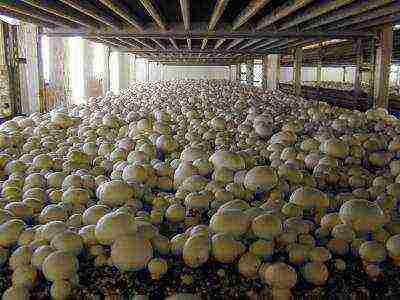
The profitability of mushroom cultivation is noted at the level of 30-50%. It is influenced by growing conditions, production volume, energy consumption and other factors. Direct expenses will be the purchase of mycelium, compost, containers, utilities, workers' salaries and others.

